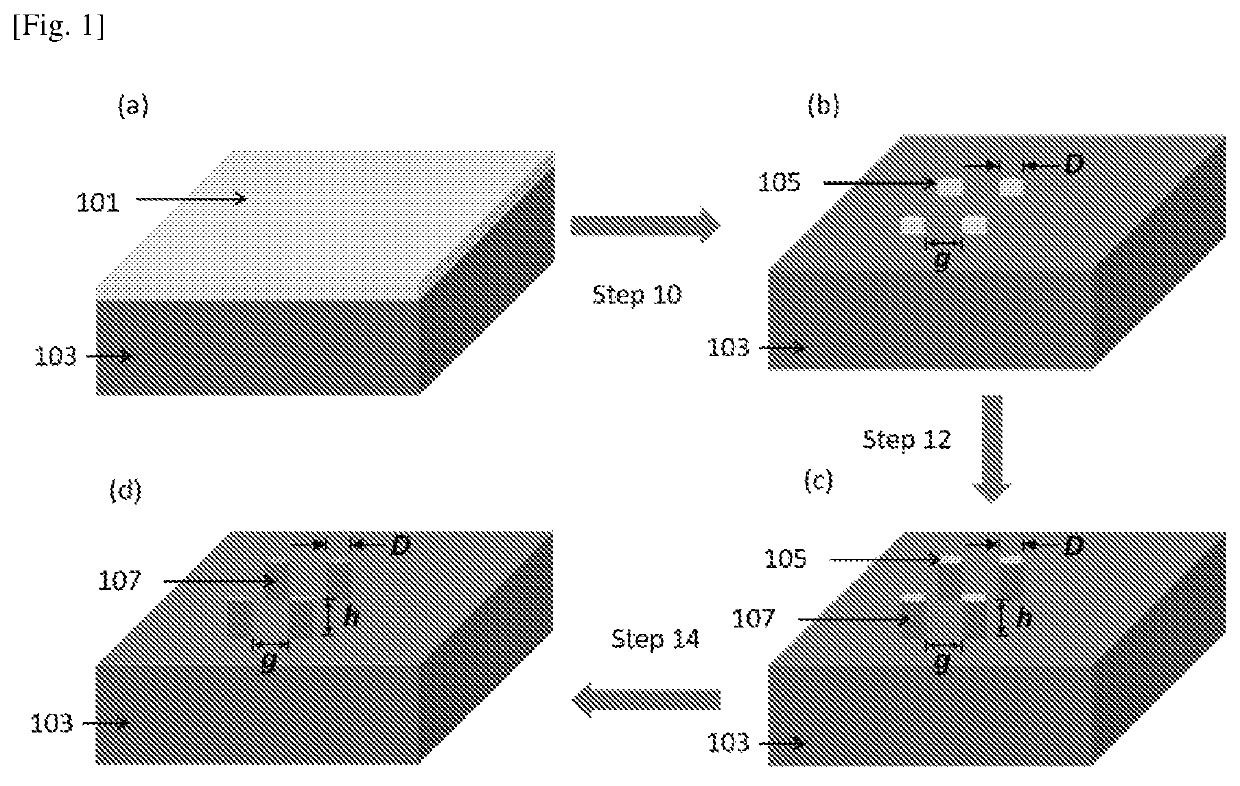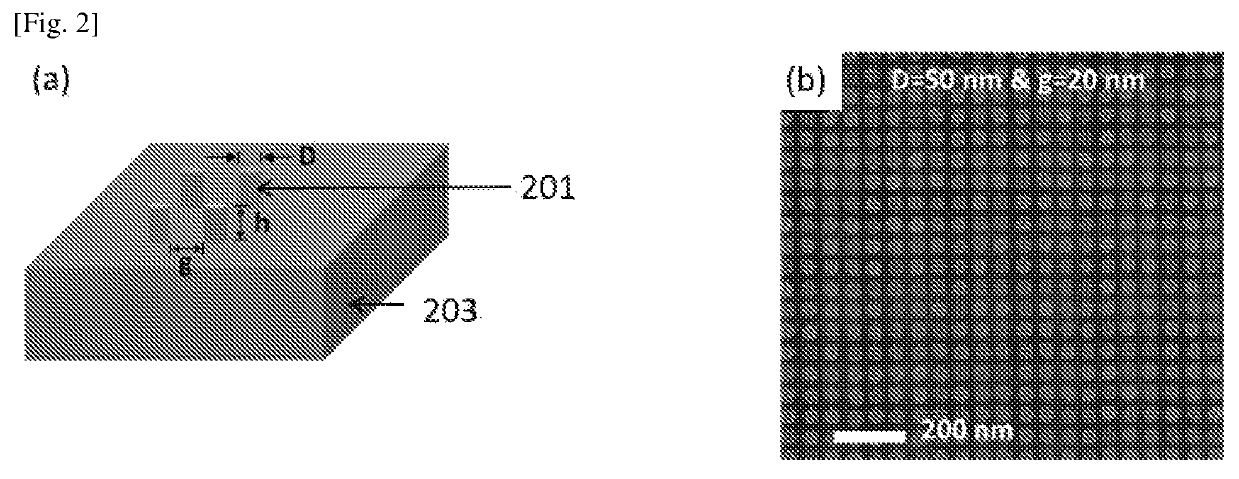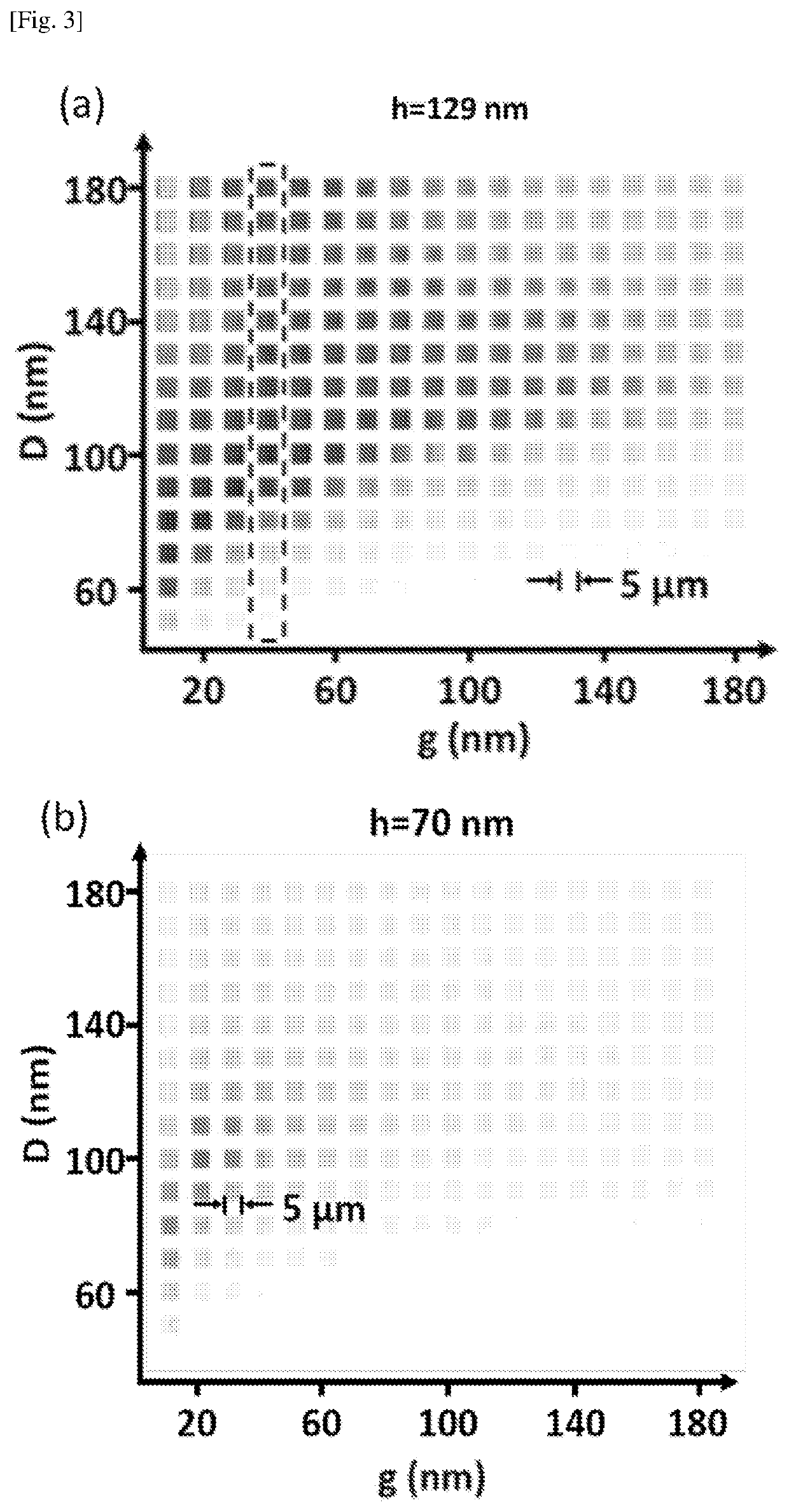Method of forming nano-patterns on a substrate
a technology of nano-patterns and substrates, applied in the field of forming nano-patterns on substrates, can solve the problems of imposing certain structural limits on the nano-wires for high-resolution colour printing, metals were not allowed in industrial semi-conductor fabrication facilities, and high-resolution colour printing technology, etc., to achieve a surprisingly vivid colour display, reduce the background optical signal, and reduce the effect of ohmic/resistive loss
- Summary
- Abstract
- Description
- Claims
- Application Information
AI Technical Summary
Benefits of technology
Problems solved by technology
Method used
Image
Examples
example 1
[0094]Fabrication of Silicon Nanodisks on a Silicon Substrate to Obtain a Basic Colour Palette for High-Resolution Colour Printing
[0095]The method of FIG. 1 is used here to form silicon nanodisks on a silicon substrate. Here, as shown in FIG. 1(a), a resist layer such as hydrogen silsesquioxane (HSQ) (Dow Corning, product number XR-1541-002) was spun coated onto a substrate (103) such as a silicon substrate to form a layer of negative electron-beam resist (101) with a thickness of 30 nm. The HSQ resist was subsequently subjected to electron beam lithography in step 10 to develop the nanodisk mask resists. The HSQ layer was subjected to a negative electron-beam exposure with an electron acceleration voltage of 100 KeV, a beam current of 500 pA and an exposure dosage of 12 mC / cm2. The HSQ resist was then developed by using NaOH / NaCl salt solution (1% wt. / 4% wt. in de-ionized water) for 60 seconds followed by immersion in de-ionized water for another 60 seconds to stop the development....
example 2
[0109]Analysis of Diamond Nanodisks by Scaling Based on a Refractive Index Ratio
[0110]The fabrication method and the analysis of the colour produced of silicon nano disks as described in Example 1 was applied to all other dielectric materials. The corresponding dimensions and inter-structure distances of the nanodisks for all other types of dielectric materials was calculated with reference to the fabricated silicon substrate based on a scaling factor. The scaling factor was defined as the ratio of the refractive index of silicon to the refractive index of a selected dielectric material, i.e., nsi / ndielectric.
[0111]Diamond nanodisks were fabricated from a diamond substrate by simulation using the finite-difference-time-domain (FDTD) method. The corresponding diameter, height and gap size were calculated by multiplying them with the scaling factor. The refractive index of diamond (ndiamond) was 2.4 and the refractive index ratio was calculated to be 1.67. Hence, the scaling factor of...
example 3
[0115]Addition of an Anti-Reflectance Dielectric Layer
[0116]To improve color fidelity of the dielectric nanostructures, an anti-reflectance dielectric layer was inserted between the dielectric nanostructures and dielectric substrate. The anti-reflectance layer significantly enhances the color fidelity of the substrate. The fundamental principle of inserting this anti-reflectance dielectric layer was to minimize the background optical signal, which was not originated from the scattering of the dielectric nano structures.
[0117]In this example, the materials used for both the dielectric nanodisks and dielectric substrates were silicon. The optimal material for the anti-reflectance dielectric layer was determined by a refractive index value calculated based on √{square root over (nairnsub)}, where nair is the refractive index of air and nsub is the refractive index of the base substrate. For a silicon substrate, the optimal anti-reflection dielectric layer should be close to 2.
[0118]The...
PUM
| Property | Measurement | Unit |
|---|---|---|
| thickness | aaaaa | aaaaa |
| diameter | aaaaa | aaaaa |
| inter-structure distance | aaaaa | aaaaa |
Abstract
Description
Claims
Application Information
 Login to View More
Login to View More - R&D
- Intellectual Property
- Life Sciences
- Materials
- Tech Scout
- Unparalleled Data Quality
- Higher Quality Content
- 60% Fewer Hallucinations
Browse by: Latest US Patents, China's latest patents, Technical Efficacy Thesaurus, Application Domain, Technology Topic, Popular Technical Reports.
© 2025 PatSnap. All rights reserved.Legal|Privacy policy|Modern Slavery Act Transparency Statement|Sitemap|About US| Contact US: help@patsnap.com



